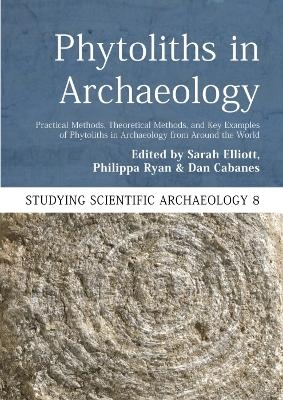
Phytoliths in Archaeology
Oxbow Books (Verlag)
978-1-78925-979-7 (ISBN)
Phytoliths are microscopic silica bodies formed in and around plant cells. Phytoliths are extremely robust and survive in most archaeological sediments. Phytoliths survive when other botanical remains do not, and they do not require charring to survive. This book summarizes how silica phytoliths can be used by archaeologists by covering practical aspects, some general theory and key examples of where phytoliths have been used to answer a wide range of research questions from around the world. The examples in this book show how phytolith analysis can contribute to our archaeological knowledge in particular past human behavior, economies and environments. This book is aimed at practicing archaeologists and students rather than phytolith specialists or environmental archaeologists. This book showcases phytolith analysis in archaeology and outlines the potential research questions that phytoliths can answer as well as how and where to take samples.
Sarah Elliott is Deputy Head of Department for Life & Environmental Sciences at Bournemouth University. She obtained her PhD from the University of Reading in 2016. Elliott specialises in geoarchaeology, environmental archaeology and palaeoecology, and has worked on phytoliths from South America, the Caribbean, Europe, and the Middle East, with a specific focus on early Neolithic farming societies in southwest Asia.149532 Philippa Ryan is a Research Group Leader in Interdisciplinary Research at the Royal Botanic Gardens, Kew, in London. Ryan specialises in ethnobotany and archaeobotany, including phytoliths and macrobotanical remains. Her work on phytoliths has focused on southwest Asia and North Africa, and has also included projects from Europe, West Africa and Central Asia. 149530 Dan Cabanes is an Associate Professor in the Department of Anthropology at Rutgers, the State University of New Jersey, and a full faculty member of the Center for Human Evolutionary Studies (CHES) and the Institute of Earth, Ocean, and Atmospheric Sciences (EOAS). Cabanes is the director of the Department of Anthropology Laboratory for MicroArchaeology (ALMA), which focuses on the study of the microscopic archaeological record. 149531
Section 1: Introduction
1: Studying phytoliths in archaeology
Section 2: Themes: The practical aspects and interpretive potential
2: Practical and theoretical methods
3: Interpretation and Palaeo-environmental reconstruction
4: Phytoliths as indications of agriculture
5: Phytoliths as dietary indicators
6: Phytoliths as indicators of anthropogenic activity
7: Phytoliths in trees and shrubs (arboreal phytoliths)
8: Interdisciplinary approaches: Integrating phytolith analysis within archaeobotany and geoarchaeology
Section 3: The greatest hits: key examples of phytoliths in archaeology
9: What can phytolith tell us about ancient urban life? Phytolith analyses in the Near East and north Africa
10: The NW European Void: Untapped potential
11: Phytoliths and recent advances in new world tropical archaeology
12: How was the landscape where humans evolved? Paleoecology from the phytolith perspective in East and South Africa
13: Phytoliths and old world tropical vegeculture from the Asia-Pacific to Africa
14: Phytoliths and the story of rice –origins, diffusions, and insights from cultivation practices into climate change and the origins of the Anthropocene
15: Phytolith analyses and the Indus Civilisation / Advances in phytolith research in Southern Asia
16: Phytoliths and Palaeolithic archaeology
Section 4: Conclusions: phytoliths in archaeology
17: Conclusions
| Erscheint lt. Verlag | 15.9.2024 |
|---|---|
| Reihe/Serie | Studying Scientific Archaeology ; 8 |
| Zusatzinfo | 100 illustrations, including some in color |
| Verlagsort | Oxford |
| Sprache | englisch |
| Maße | 170 x 270 mm |
| Themenwelt | Geisteswissenschaften ► Archäologie |
| Naturwissenschaften ► Biologie ► Botanik | |
| ISBN-10 | 1-78925-979-7 / 1789259797 |
| ISBN-13 | 978-1-78925-979-7 / 9781789259797 |
| Zustand | Neuware |
| Haben Sie eine Frage zum Produkt? |
aus dem Bereich


